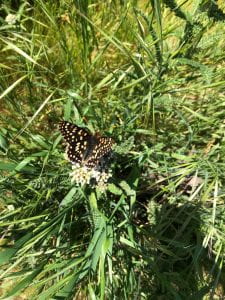https://ebird.org/checklist/S69004396
Field Lab Entry 12
Ebird List Link: https://ebird.org/checklist/S68614450
Date: 05/08/20
Location: Presidio of San Francisco, San Fransisco County ( 37.78738, -122.47458) at an elevation of approximately 243 feet (74 meters). Refer to the map for where observations were recorded.
Site Description: Observations were done along a trail in the Presidio. The site consisted of a series of rolling hills at a moderate elevation. The majority of the observations were done down at a lower elevation on a footpath. The habitat was mostly open-aired, with a few tall pine and oak trees surrounding the border of the site. The site had very dense vegetation that consisted of a variety of bushes, shrubs, and grasses. The most abundantly observed species were: Common Ravens (18), American Crows (8), Anna’s Hummingbirds (8), White-crowned Sparrows (6), gull species (5), and Rufous Hummingbirds (4). Other species observed were: Cliff Swallows (3), swallow species (2), American Robins (2), House Finches (2), a Mourning Dove (1), a California Scrub-Jay (1), and a Song Sparrow (1).
Species Account: I have consistently been coming back to this site to do my observations. Every time that I come to this site, I always see species of swallows. I am able to identify that the species I am seeing are swallows due to their slender streamlined bodies and pointed wings. Additionally, I recognize their speed and undulating flight as unique from the other birds I have observed in the area. However, I have faced difficulty in identifying which swallow species I am seeing. When I do spot the swallows, they are zipping through the air and high up. In this position, the sun usually makes it hard to discern more specific morphological characteristics of the birds that are key to differentiation and identification. Their speed also makes it hard for me to follow them to a landing place, which is often beyond the power that my binoculars can see to. I was able to get a glimpse of the underside plumage color on a group of three swallows that flew over me. They were close enough and unobstructed by the shadowing effects of the sun. All three of the swallows had a white underside. From a discussion we had in our class previously about differences between Barn Swallows and Cliff Swallows, I remembered that Cliff Swallows were the species that had flashy white undersides. Based on this, I identified the three birds as Cliff Swallows. Cliff Swallows (Petrochelidon pyrrhonota) are of order Passeriformes and of family Hirundinidae. They are a small and compact bird, comparable to the size of a sparrow. They have rounded, broad-based wings with small heads and medium length squared tails. With good light, these swallows have metallic, dark-blue backs and pale, pumpkin-colored rumps. In poor light, they may appear to look brownish with dark throats and white underparts. Their faces have a reddish-brown color with a dark blue cap atop of the head and a white patch on the forehead. This species inhabits a wide variety of habitats, predominately grasslands, towns, broken forests, and river edges. Cliff Swallows are colony nesters and have been found commonly nesting on human-made structures, such as bridges and buildings. This species is interesting because both the male and female help to build the nest, gathering mud and grasses. Cliff Swallows are aerial foragers and insectivores, with a preference for flying insects. As mentioned above, these swallows form colonies. They preen, feed, drink, and bathe in groups, and they continue sticking together in large flocks during migration and on their wintering grounds.


Sources:
- “Cliff Swallow – Ebird.” Ebird.Org. https://ebird.org/species/cliswa. Accessed 8 May 2020
- “Cliff Swallow – All About Birds.” Allaboutbirds.Org. https://www.allaboutbirds.org/guide/Cliff_Swallow/lifehistory. Accessed 8 May 2020
Narrative: Observations occurred along a trail over 1.14 miles. The weather was sunny with clear skies. The temperature was between 65-70 degrees Fahrenheit. A low diversity of species was observed at this site today compared to past observations done at the same site previously. However, a moderately higher abundance of Common Ravens, American Crows, and Anna’s Hummingbirds were observed; very typical and common inhabitants of this site. Over the duration of the trip (59 minutes), ten species were observed. On this day I did not get the opportunity to observe any very unique behaviors, in fact, I did not see as many birds as usual. I was hearing lots of songs and sounds from a variety of species, but could not visibly locate them because they were remaining hidden in the dense vegetation. There was flocking behavior exhibited by the Common Ravens, they were flying together in a group of about 10. I was able to hear the back and forth calls of many White-crowned Sparrows and Song Sparrows.
Additional Photos and Media:
Field Lab Entry 11
Ebird List Link: https://ebird.org/checklist/S68475233
Date: 05/06/20
Location: China Beach of San Francisco, San Francisco County, (37.788000, -122.491078) at an elevation of approximately 500 feet (152.4 meters). Refer to the map for where observations were recorded.
Site Description: Observations were taken at sea level, from the sand, in a small cove. The cove faced the Golden Gate Bridge, providing a view towards the bay entrance. The beach itself was an open-aired habitat that had no trees, bushes, or grasses. However, the cove was surrounded by highly elevated cliffs that had a dense amount of trees to the left side. On the right side of the cliffs were residential neighborhoods. The most abundantly observed species were: Gull species (69) and Brown Pelicans (14). Other species observed were: American Crows (3), Common Ravens (2), Least Sandpipers (2), a Barn Swallow (1), and. Double-crested Cormorant (1).
Species Account: The majority of the birds I observed were a species of gull. I had seen two larger sized flocks flying high in the sky. Towards the end of my observations, I saw another large flock of about 14 birds. The flock was directly over me when I noticed it, flying from inland to out towards the shore. At first glance, slightly obscured by the setting sun, I assumed that the flock was a flock of seagulls since that was the most abundant bird I had been seeing at this location. As the flock flew into a better position for my viewing, I immediately noticed that the bills of the birds were much longer and the bodies of the birds were much bigger. Additionally, the necks of these birds were more elongated than a seagull’s. I was able to identify the birds in the flock as Brown Pelicans. Brown Pelicans (Pelecanus occidentalis) are of order Pelecaniformes and of family Pelecanidae. This species is a large-sized seabird bird, comparable to the size of a goose. They are heavy-bodied and stocky birds. As adults, their body plumage is gray-brown with yellow heads and white necks. During the breeding season, their plumage may change over to a more dark reddish-brown color. Their wings are long, broad, and bowed, well suited for constant gliding. They have thin necks, long bills, and stretchy throats. This aspect of their morphology enhances their ability to feed, they plunge into the water to scoop up fish and hold them in their expandable throat pouches. Brown Pelicans are found inhabiting sea coasts from the west to the southern United States and are rarely seen inland. When they nest, they nest in colonies in areas free from predators. Although the species is fairly common today, they were pushed to the brink of extinction from pesticide pollution (DDT) that ultimately weakened the shells of the eggs they were laying.


Sources:
- “Brown Pelican – All About Birds.” Allaboutbirds.Org. https://www.allaboutbirds.org/guide/Brown_Pelican/overview. Accessed 6 May 2020
- “Brown Pelican – Ebird.” Ebird.Org. https://ebird.org/species/brnpel. Accessed 6 May 2020
Narrative: Observations occurred from a single location on the beach, without any movement, because the spot provided a clear view of the entire cove. The weather was sunny with moderate gusts of wind. The temperature was between 65-70 degrees Fahrenheit. A low diversity of species was observed with a low abundance of each. With the exception of the gull species and the Brown Pelicans. Over the duration of the trip (58 minutes), six species were observed. As I mentioned before, gull species was the most commonly observed bird. I saw gulls that varied morphology, such as size and plumage color, but I was unable to discern between the species. I recognize that I was likely seeing many different species of gulls, however, I was forced to group them all into one undescriptive category. I saw many flocks of 15-20 gulls flying together and was interested to know if they were a mixed-species flock of gulls. I also noticed that when I observed the Brown Pelican flock flying through the sky, there were some seagulls mixed in with them. It made me wonder if they just happened to overlap by coincidence or if they were actually flocking together for prolonged periods of time. I love the idea that different species of birds come together and work together to benefit each other. Another thing I observed was two Sandpipers wading near the shoreline together. I was able to watch them probe into the sand with their beaks looking for food. It was easy for me to identify these birds as this species because of their narrow legs and wings.
Additional Media and Photos:
Field Lab Entry 10
Ebird List Link: https://ebird.org/checklist/S68402485
Date: 05/04/20
Location: Presidio of San Francisco, San Fransisco County ( 37.78738, -122.47458) at an elevation of approximately 243 feet (74 meters). Refer to the map for where observations were recorded.
Site Description: Observations were done along a trail in the Presidio. Some observations were done along a paved path at a higher elevation looking out towards the coast. The majority of observations were done along a dirt path in a densely packed forest with tall gum trees, pine trees, and some grasses. The density of the forest provided a cooler, shaded habitat. The forest also had several dead standing and fallen trees dispersed throughout it. The forest site was at a lower elevation with a gradual hill decline towards sea level. At the forest edge, there was an open-aired area with no trees and only small shrubs. The most abundantly observed species were: White-crowned Sparrows (8), American Crows (7), Anna’s Hummingbirds (3), Red-tailed Hawks (3), Song Sparrows (3), American Robins (2), Barn Swallows (2), and gull species (2). Other species observed were: a Chestnut-backed Chickadee (1), a Common Raven (1), a California Scrub-Jay (1), and a Great-horned Owl (1).
Species Account: I stopped on my walk down the dirt path through the forest to take a seat on a fallen gum tree in the shade. From this spot I had a good visual of the dark dense forest to my right, and the bright open-aired habitat to my left. The skies were clear and the temperature was warmer than usual, so the birds were singing perched in the shade provided by the tall trees. I was having difficulty locating birds, their size was made seemingly even smaller due to the height of the trees. Additionally, they hid and camouflaged so well under the cover of the trees. I was forced to scan back and fourth across the tree tops searching for movement that would potentially lead to a bird sighting. To my surprise, I eventually spotted a rather large bird perched perched close to the tree trunk. At first glance I thought that it must have been a Red-tailed Hawk because that was one of the species I have been seeing consistently when I come to this site. The bird’s plumage was mottled brown, excellent for blending into the tree’s trunk. I also got a briefly glance at the bird’s eyes, which were a sort of glowing yellow color. Both the plumage and eye color were associated with what I had seen when I got good looks at Red-tailed Hawks. However, with further observation I realized that the bird’s features were distinct and that it was not a hawk. This bird’s body was wider than the slender, streamlined body of the hawk. Its eye color was similar to the hawk, but its eyes were much larger with a flattened, circular patterned face. The most defining feature was the little tufts of feathers that stuck out from both sides of the top of the head. With these features and news from other birders seeing owls at this site, I was able to identify the bird as a Great-horned Owl. Great-horned Owls (Bubo virginianus) are of order Strigiformes and of family Strigidae. They are large owls with thick bodies, rounded heads, short bills, and feathered ear tufts. Their plumage is typically mottled gray-brown with a white patch near the throat. Their facial discs vary across regions from gray to cinnamon. Great-horned Owls can found inhabiting a large range of habitats: deciduous and evergreen forests, swamps, desert, tundra edges, and tropical rainforest, as well as cities, orchards, suburbs, and parks. They are a nocturnal species that can primarily be found nesting in trees during the day. These owls prey on a variety of mammals, birds, and reptiles. They capture their prey using their excellent hearing, which is enhanced by their asymmetric faces, and silent, aerial diving. The Great-horned Owl call is described as a deep, stuttering series of four to five hoots. Males and females may be heard engaging in back and fourth hooting duets.
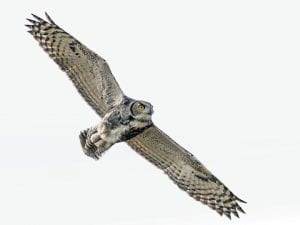

Sources:
- “Great-horned Owl – All About Birds.” Allaboutbirds.Org. https://www.allaboutbirds.org/guide/Great_Horned_Owl/overview. Accessed 5 May 2020
- “Great-horned Owl – Ebird.” Ebird.Org. https://ebird.org/species/grhowl. Accessed 5 May 2020
Narrative: Observations occurred along a trail over 0.67 miles. The weather was sunny with clear skies. The temperature was between 65-70 degrees Fahrenheit. A moderate diversity of species was observed with a low abundance of each. This was likely not an accurate survey of the species dispersed throughout the area, most of my time was spent observing the Great-horned Owl. Over the duration of the trip (59 minutes), thirteen species were observed. The most abundant species that I observed were the White-crowned Sparrows. I noticed that groups of about three to four sparrows were gathering together on bush tops and singing their songs. They jumped from branch to branch but remained on the same bush as their fellow sparrows. The singing behavior and the frequency at which I’m now seeing the sparrows together leads me to suspect that breeding may be occurring right now. On the topic of breeding, when I was walking through the forest area I noticed a standing dead tree that had holes in the trunk large enough for a small bird to enter into. I believe that a small bird species was potentially using this as a nesting site (photo of this can be seen below under additional media and photos). After repeatedly coming back to this site, I noticed that there is always an Anna’s hummingbird that perches at the top of one of the medium-sized trees during warmer days. The tree is located right at the entrance of the trail that I walk on, so I pass it often. I have yet to observe the hummingbird protect its territory from another bird trying to perch on it. A cool behavior I was able to witness was the hunting of a California Scrub-Jay. The bright blue plumage caught my eye in the open-aired habitat, and I watched as the bird dove down to the ground and came right back up with a worm in its mouth. The jay then proceeded to perch on a tree branch to eat his meal.
Additional Photos and Media:
Time Home 5
https://ebird.org/checklist/S67908752
Time Home 4
https://ebird.org/checklist/S67870768
Field Lab Entry 9
Ebird List Link: https://ebird.org/checklist/S67699129
Date: 04/23/20
Location: Presidio of San Francisco, San Fransisco County ( 37.78738, -122.47458) at an elevation of approximately 243 feet (74 meters). Refer to the map for where observations were recorded.
Site Description: Observations were done along a trail in the Presidio. The site consisted of a series of rolling hills at a moderate elevation. The majority of the observations were done along the cemented footpath on the trail, which ran along the edge of a cliff overlooking the coast and open-aired area at the highest elevation. The footpath was bordered by a variety of medium-height trees and a dense amount of bushes. Some observations were taken down at a lower elevation, which had dense amounts of tall gum trees and pine trees with some grasses. The most abundantly observed species were: American Crows (43), Turkey Vultures (8), Anna’s Hummingbirds (5), Common Ravens (4), Rufous Hummingbirds (4), White-crowned Sparrows (4), Red-tailed Hawks (3), and American Robins (3). Other species observed were: Gull species (2), House Finches (2), Song Sparrows (2), a Mourning Dove (1), a Double-crested Cormorant (1), a Great Blue Heron (1), a Western Wood-Peewee (1), a California Scrub-Jay (1), and a White-throated Sparrow (1).
Species Account: My attention was drawn to a bird perched on top of a bush, calling in spaced-out high pitched buzzes. Listening closely, I would say that the vocalization was slightly oscillating between a higher and lower pitch. The bird was not far from me, so I was able to get a detailed look at its morphology. Upon first glance, I thought that it was a Black Phoebe because of the uniquely shaped head. The plumage atop of the head led up to a rounded point near the center of the skull. The subtle white wing bars I had observed in Black Phoebes were also present in this bird. However, there were some differences I noticed that led me to speculate it may have been another species. The majority of the body plumage was a grey color, lighter than the black color I had consistently observed in the Black Phoebes. I did note that this may just be due to variation within the species, but the body shape furthered my speculation it was actually was a different species. The body of this bird was narrow with a more pointed tail compared to the Phoebe’s rounded body and blunted tail. My identification of the bird based on morphology was that it was a Western Wood-Pewee. Western Wood Pe-wees (Contopus sordidulus) are of the order Passeriformes and of family Tyrannidae. They are medium-sized flycatchers that have a peaked crown, giving them a triangular looking shaped head. Their bodies are long and slender, the longer length of the Western Wood-Pewee’s wings differentiates it from other similar looking flycatcher species. The majority of their plumage is a grayish-brown color, with two white wing bars and a lighter gray on their underside. Western Wood Pewee’s are often said to look like they are wearing a partially buttoned gray vest. Their peaks are small and pointed, suited to their diet of insects. This species is known for its perching behavior when hunting they often return to the same initial perch. A key identifying behavior is that this species does not flick its tail while perched, like many species of flycatchers, do. The Western Wood-Pewee’s call is a reflection of its name, they sing “pewee” in a tone best described as burly and nasally. This species mainly inhabits open woodlands, forest edges, and forests near streams with large trees. They tend to avoid dense forests. The Western and Eastern Wood-Pewees are nearly identical morphologically and having breeding zones that overlap in a narrow area in the Great Plains. Despite this, no evidence has been found that the two species interbreed in this area. It is suspected that breeding may not occur because of how different each species’ song is.
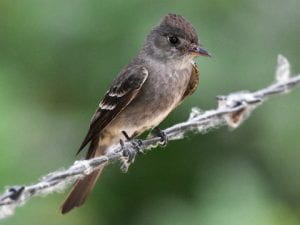
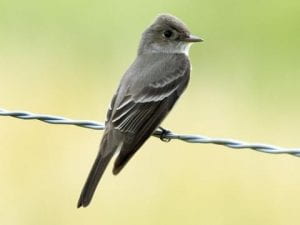
Sources:
- “Western Wood-Pewee – Ebird.” Ebird.Org. https://ebird.org/species/wewpew. Accessed 26 April 2020
- “Western Wood-Pewee – All About Birds.” Allaboutbirds.Org. https://www.allaboutbirds.org/guide/Western_Wood-Pewee. Accessed 26 April 2020
Narrative: Observations occurred along a trail over 0.55 miles. The weather was sunny with clear skies. The temperature was between 60-65 degrees Fahrenheit. A moderate diversity of species was observed with a low abundance of each, however, there was an exception with the American Crows, which had a high abundance. Over the duration of the trip (64 minutes), fifteen species were observed. The American Crows I observed were all at once, flying chaotically in a large flock in a circular motion. I believe they were potentially exhibiting group hunting behavior or competing over food. I had difficulty identifying crows from ravens, after remembering that crows have fan-like tails while ravens have more diamond-shaped tails. I was able to confirm that the members of the flock were indeed American Crows based off of tail morphology. As I saw on my last visit, the Anna’s Hummingbirds were still doing their mating displays, flying up high in a straight line then quickly diving down into a J-shape. I believe that I actually observed a male Anna’s Hummingbird attempting to impress a female because the male was being more vocal than I had ever heard before. The male was also zipping very quickly around one specific bush while he was vocalizing. Another interesting thing I noticed was plumage on a pair of House Finches. As I walked, a brilliant bright red color upon the telephone wire caught my eye. At first, I assumed it was an Anna’s Hummingbird with direct sunlight hitting its plumage. I find that the hummingbirds often perch on this telephone wire. However, the bird was much too large to be a hummingbird species. When I looked with my binoculars, the bird more so resembled a sparrow body type with a long tail. I was then able to identify the pair of birds as finches, the red color I observed was consistent with House Finches.
Additional Photos and Media:
Time Home 3
https://ebird.org/checklist/S67358256
Time Home 2
https://ebird.org/checklist/S67236250
Field Lab Entry 8
Ebird List Link: https://ebird.org/checklist/S67180911
Date: 04/14/20
Location: Presidio of San Francisco, San Fransisco County ( 37.78738, -122.47458) at an elevation of approximately 243 feet (74 meters). Refer to the map for where observations were recorded.
Site Description: Observations were done along a trail in the Presidio. The site consisted of a series of rolling hills at a moderate elevation. The majority of the observations were done along the cemented footpath on the trail, which ran along the edge of a cliff overlooking the coast and open-aired area at the highest elevation. The footpath was bordered by a variety of medium-height trees and a dense amount of bushes. Some observations were taken down at a lower elevation, which had dense amounts of tall gum trees and pine trees with some grasses. The most abundantly observed species were: Song Sparrows (8), Swallow species (7), Anna’s Hummingbirds (4), Tree Swallows (4), White-crowned Sparrows (3), Red-tailed Hawks (3), California Scrub-Jays (3), and Chestnut-backed Chickadees (3). Other species observed were: American Crows (2), Barn Swallows (2), American Robins (2), a Gull species (1), a Wrentit (1), a Fox Sparrow (1), and a Dark-eyed Junco (1).
Species Account: Walking along the footpath, I caught a glimpse of a bright on the telephone wire. Using my binoculars for a better view, it was a small-sized bird and the plumage on the front of its body was glowing an iridescent magenta in the sunlight. I immediately knew that it was a hummingbird, either an Anna’s or Allen’s (the two that we have most commonly seen in the area). It was possible it could have been a Rufus, which have recently started migrating here. However, because of the distinct magenta-colored throat, I eliminated the possibility of an Allen’s or Rufus and identified the species as an Anna’s. In addition, I saw another similar small body-sized bird exhibiting a unique behavior. The bird ascended in a straight line up into the sky, then would dive down in a J-shape. The bird was high up and zipping around rather quickly, so it was hard to get a clear look at it for identification based on morphology. But I recalled that this J-shaped diving display was a mating behavior in male Anna’s Hummingbirds, and therefore was able to identify the bird based on behavior. The Anna’s Hummingbirds (Calypte anna) are of the order Caprimulgiformes and of family Trochilidae. They are a small-sized bird with a large head and stocky body. Their beaks are short, narrow, and pointed. The feature about them that is the most striking and easily identifiable is their plumage coloring. Their bodies are mostly green and gray, but the males have a reddish-pink coloring on their heads and throats in the sunlight. However, when not in direct sunlight they may just appear as dull gray or brown. This species is found inhabiting a wide variety of places, but favor open-aired habitats such as woodlands, desert scrubs, and chaparral areas. They can also be found inhabiting residential areas, backyards, and parks. Anna’s Hummingbirds are primarily nectarivores, but also feed on small insects. Due to their diet, they are commonly found hovering over flowers searching for nectar and insects; their small body-size gives them a very quick metabolism that requires them to be frequently eating. Their ability to beat their wings so fast generates the humming noise that we hear when they fly. The males exhibit a unique song that is best described as metallic and scratchy. This species of hummingbird is the only species that regularly winters in northern California, Oregon, and Washington.
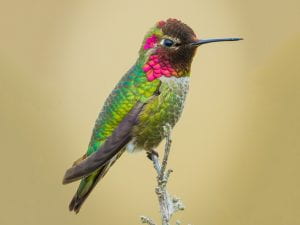

Sources:
- “Anna’s Hummingbird – Ebird.” Ebird.Org. https://ebird.org/species/annhum. Accessed 17 April 2020
- “Anna’s Hummingbird – All About Birds.” Allaboutbirds.Org. https://www.allaboutbirds.org/guide/Annas_Hummingbird/id. Accessed 17 April 2020
Narrative: Observations occurred along a trail over 0.86 miles. The weather was sunny with clear skies. The temperature was between 65 to 70 degrees Fahrenheit. As observed in this area before, there was a moderate diversity of species with low abundance of birds. I noticed that I observed more or less the same species from my previous visit to the site. Over the duration of the trip (56 minutes), fifteen species were observed. On this day I noticed that I was hearing a lot more bird songs and what appeared to be communication between birds. This led me to wonder if it was the mating season for some of the birds, specifically the sparrows which I believe I was hearing the most. But the warm weather could have just been another reason that the birds were all out and singing that day. I was able to get a closeup look of a song sparrow perched atop a bush singing, it was interesting to watch how such a small bird can generate such a piercing and loud noise. As I mentioned above, I was seeing a few different Anna’s Hummingbirds exhibiting their J-shaped dives. I also saw a group of three Red-tailed Hawks soaring with each other, taking advantage of the thermals on a warm day. For a portion of the hike, I was at a lower elevation surrounded by tall trees. Most of my time spent here was searching for a woodpecker that I could hear pecking away at the wood. Unfortunately, I was unable to locate the woodpecker and therefore could not identify it. Another thing that I observed that was really cool was the feeding behavior of a California Scrub-Jay. I initially located the jay picking a berry from off of a bush, it then flew with the berry in its mouth and landed on a telephone wire to eat it. I should note that the call of the California Scrub-Jay is something that I am now easily able to identify, a scratchy sound that is successively repeated.
Additional Photos and Media:

















